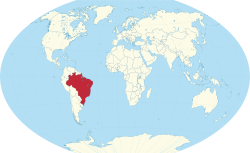Biology:Nymphaea vanildae
| Nymphaea vanildae | |
|---|---|
| Scientific classification | |
| Kingdom: | Plantae |
| Clade: | Tracheophytes |
| Clade: | Angiosperms |
| Order: | Nymphaeales |
| Family: | Nymphaeaceae |
| Genus: | Nymphaea |
| Species: | N. vanildae
|
| Binomial name | |
| Nymphaea vanildae C.T.Lima & Giul.[1]
| |

| |
| Nymphaea vanildae is endemic to Brazil[1] | |
Nymphaea vanildae is a species of waterlily endemic to Pernambuco, Brazil.[1]
Description
Vegetative characteristics
Nymphaea vanildae is an aquatic herb[2] with cylindrical tubers, which are likely not stoloniferous.[3] The roots are contractile.[4]
Generative characteristics
The strongly brittle, brownish, glabrous peduncle has five primary central and ten secondary peripheral air canals.[4] The androecium consists of 98–100 stamens. The outer lanceolate, 4.2–4.4 cm long and 1–1.1 cm wide stamens have white filaments. The inner stamens measure 2.1–2.4 cm × 1.9–2.2 mm, with reddish-purple filaments. The outer stamens have white to yellow-green, 0.2–0.4 mm long terminal extensions of the filament. The inner stamens do not have these extensions. The yellowish-white anthers are 3.5–5 mm long in the outer stamens and 5–7 mm long in the inner ones. Staminoids are absent.[3] The gynoecium consists of 21-25 carpels with flat, linear, 7.5–9.0 mm long and 2.0–2.8 mm wide appendages with a rounded apex. The apex and base is cream-coloured, while the remaining parts display a reddish-purple colouration.[4]
Reproduction
Vegetative reproduction
Stolons were not observed, but Nymphaea vanildae reproduces vegetatively through proliferating pseudanthia.[3]
Generative reproduction
No fruits have been observed.[3]
Taxonomy
It was first described by C.T.Lima and Ana Maria Giulietti in 2013.[1]
Type specimen
The type specimen of Nymphaea vanildae was collected by C.T. Lima and L. Lima in Lagoa Grande, Pernambuco, Brazil, 50 km from the municipality of Petrolina, on the 23rd of April 2011.[3]
Placement within Nymphaea
It is placed in Nymphaea subgenus Hydrocallis.[3]
Etymology
The specific epithet vanildae honours Maria Vanilda Morais Oliveira of the State University of Feira de Santana.[4]
Conservation
It is thought to be critically endangered (CR). Its fragmented habitat is only about 100 km2 (39 sq mi) in size.[4]
Ecology
Habitat
It occurs in the aquatic habitats of the Brazilian Caatinga.[2] It occurs in temporary lagoons.[3]
References
- ↑ 1.0 1.1 1.2 1.3 Cite error: Invalid
<ref>tag; no text was provided for refs namedPOWO - ↑ 2.0 2.1 Pellegrini, M. O. O. & Jardim Botânico do Rio de Janeiro. (n.d.-b). Nymphaea vanildae C.T.Lima & Giul. Flora E Funga Do Brasil. Retrieved December 17, 2023, from https://floradobrasil.jbrj.gov.br/FB139683
- ↑ 3.0 3.1 3.2 3.3 3.4 3.5 3.6 de Lima, C. T., Machado, I. C., & Giulietti, A. M. (2021). "Nymphaeaceae of Brasil." Sitientibus série Ciências Biológicas, 21.
- ↑ 4.0 4.1 4.2 4.3 4.4 De Lima, C. T., & Guilietti, A. M. (2013). "Nymphaea vanildae (Nymphaeaceae): A new species from the Caatinga in Brazil." Phytotaxa, 134(1), 42-48.
Wikidata ☰ Q17253244 entry
 |

